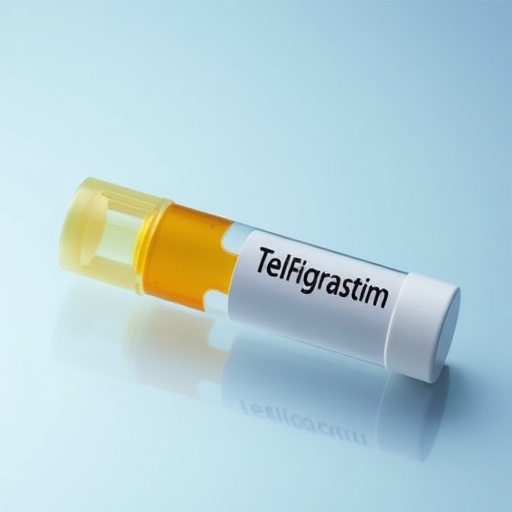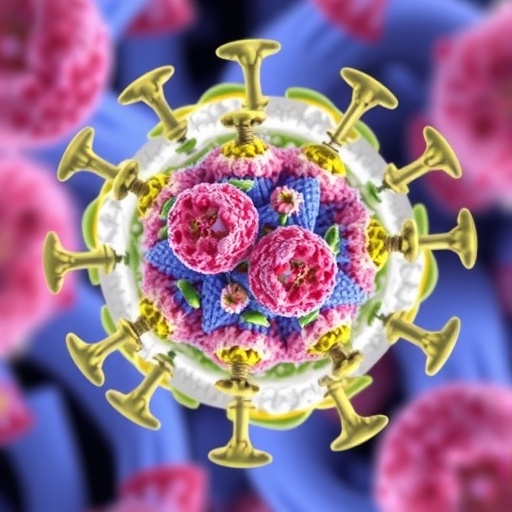In the evolving landscape of cancer treatment, chemotherapy remains a cornerstone strategy despite its notorious side effects, among which chemotherapy-induced neutropenia (CIN) represents a significant clinical challenge. CIN markedly elevates the risk of infections and febrile neutropenia (FN), posing life-threatening complications for patients with non-myeloid malignancies. Addressing this dire need, a recent multicenter, retrospective study has spotlighted telpegfilgrastim, a long-acting granulocyte colony-stimulating factor (G-CSF) analog, for its potential to mitigate these risks in patients receiving chemotherapy.
Telpegfilgrastim functions by stimulating the bone marrow to produce neutrophils, the critical white blood cells responsible for immune defense against infections. By reducing neutropenia’s severity and duration, this agent could fundamentally reshape supportive care protocols in oncology. The study, encompassing 110 patients categorized by timing of prophylaxis administration—either on the second or third day post-chemotherapy—evaluated both the efficacy and safety profiles of this therapeutic intervention in a real-world clinical context.
One of the standout findings was the notably lower incidence of severe grade 3/4 CIN in patients receiving telpegfilgrastim on the second day post-chemotherapy compared to those treated on the third day. Specifically, the incidence rates were 5.59% and 8.89% respectively, indicating a temporal advantage when the drug is administered earlier in the chemotherapy cycle. This finding is clinically significant, as reducing the incidence of severe neutropenia directly correlates with decreased infection rates and hospitalization needs.
Moreover, febrile neutropenia, a particularly dangerous complication characterized by fever alongside neutropenia, was completely absent in the second-day administration group, contrasting with a 2.22% incidence in the third-day group. This marked reduction reinforces the importance of optimal timing in delivering prophylactic agents to maximize clinical benefit and prevent life-threatening episodes in immunocompromised patients.
The study further dissected antibiotic usage patterns as a proxy for infection rates, revealing lower reliance on antimicrobial therapies in the second-day group. This outcome supports the hypothesis that telpegfilgrastim, when given at the appropriate time, not only boosts neutrophil counts but also effectively shields patients from infections that might otherwise necessitate extensive antibiotic treatments, which carry their own risks such as resistance and toxicity.
A particularly compelling aspect of the research involved the examination of absolute neutrophil counts (ANC). Patients receiving telpegfilgrastim on the second day demonstrated a statistically significant rise in ANC to normal levels as early as the first chemotherapy cycle. Importantly, this elevated ANC persisted beyond the initial treatment, suggesting sustained hematologic recovery with repeated cycles. Conversely, patients treated on the third day did not experience significant ANC improvements, underscoring the importance of prophylaxis timing in neutrophil recovery dynamics.
The study’s analysis also distinguished between primary and secondary prophylaxis, meaning whether telpegfilgrastim was administered from the first chemotherapy cycle or only after an initial episode of neutropenia. Primary prophylaxis showed marked superiority, with grade 3/4 CIN incidences at 2.82% for second-day and 4.17% for third-day groups, compared to 7.78% and 14.29% respectively for secondary prophylaxis. The incidence rate ratio of 0.35 favored primary prophylaxis significantly, with a p-value of 0.028, highlighting a statistically robust benefit in initiating telpegfilgrastim early to preempt neutropenic complications.
Safety considerations are paramount in adjunctive cancer therapies, and telpegfilgrastim exhibited a favorable tolerability profile. Only one patient in each timing cohort reported bone pain, a known but generally manageable side effect of G-CSF therapy. Crucially, no serious adverse events emerged, suggesting that telpegfilgrastim can be integrated safely into chemotherapy regimens without adding undue toxicity burden.
This evidence collectively points to telpegfilgrastim as not just an effective neutropenia prophylactic but also a transformative addition to chemotherapy supportive care. For patients facing high- or medium-risk non-myeloid malignancies, the timing of administration emerges as a pivotal factor that could dictate clinical outcomes, highlighting the nuanced interplay between pharmacodynamics and treatment schedules.
Telpegfilgrastim’s long-acting nature presents practical advantages over shorter-acting G-CSF agents, minimizing the frequency of injections and potentially improving patient adherence and quality of life. In oncology, where treatment intensity often necessitates complex regimens, such streamlined supportive therapies confer significant logistical and psychological benefits to both patients and healthcare providers.
These results, derived from a real-world multicenter context, add robustness to the growing body of literature advocating for earlier and proactive neutropenia management. They also spark new inquiries into whether patient-specific factors, such as genetic polymorphisms and chemotherapy regimen variations, might further refine telpegfilgrastim dosing and scheduling to maximize efficacy.
While retrospective in nature, limiting causative assertions, the study invites prospective randomized controlled trials to validate these findings and potentially establish new standards of care. Additionally, exploring telpegfilgrastim’s utility across diverse populations and malignancy subtypes could broaden its clinical applicability.
Future investigations might also unravel the molecular and cellular mechanisms by which this agent exerts its sustained neutrophil proliferative effects, deepening our understanding of hematopoietic recovery post-chemotherapy. Understanding such pathways could pave the way for combinatorial strategies integrating telpegfilgrastim with emerging immunotherapies or targeted treatments.
In summary, the compelling data from this multicenter retrospective study underscore telpegfilgrastim’s efficacy and safety as a prophylactic agent for chemotherapy-induced neutropenia. Patients receiving the drug on the second day after chemotherapy garnered the most benefit, with significant reductions in CIN, FN, antibiotic use, and infection incidence. Moreover, primary prophylaxis offers superior protection compared to secondary use, solidifying early intervention as a critical clinical approach.
This research heralds a promising advancement in supportive oncology care, emphasizing how optimizing timing and proactive strategies can mitigate one of the most daunting complications of cancer therapy—neutropenia. Telpegfilgrastim’s emerging role may not only improve patient outcomes but also alleviate healthcare burdens associated with infection management and hospitalization.
As cancer treatment pushes forward with new modalities and intensification strategies, innovative supportive agents like telpegfilgrastim will be indispensable in enabling patients to tolerate and complete potentially curative chemotherapy regimens. The future of oncology will rely heavily on such integrative approaches that marry efficacy with manageable safety profiles, ultimately enhancing survival and quality of life for millions worldwide.
The study’s findings illuminate a pathway where the intricacies of hematopoietic support intersect with clinical oncology, pointing towards more personalized, timing-sensitive care paradigms. Clinicians may soon adopt telpegfilgrastim as a frontline prophylactic tool, reshaping guidelines and best practices in managing chemotherapy-induced neutropenia among vulnerable cancer patient populations.
Subject of Research: Chemotherapy-induced neutropenia prevention using telpegfilgrastim in patients with high- or medium-risk non-myeloid malignancies.
Article Title: Telpegfilgrastim for the prophylaxis of chemotherapy-induced neutropenia in patients with high- or medium-risk non-myeloid malignancies: a multicenter, retrospective study
Article References:
Zheng, Y., Zhang, Y., Li, J. et al. Telpegfilgrastim for the prophylaxis of chemotherapy-induced neutropenia in patients with high- or medium-risk non-myeloid malignancies: a multicenter, retrospective study. BMC Cancer 25, 1571 (2025). https://doi.org/10.1186/s12885-025-14911-5
Image Credits: Scienmag.com
DOI: https://doi.org/10.1186/s12885-025-14911-5
Tags: cancer treatment supportive careefficacy of telpegfilgrastim in oncologyimmune system support during chemotherapylong-acting granulocyte colony-stimulating factorneutrophil production stimulationnon-myeloid malignpreventing febrile neutropenia in cancer patientsreal-world clinical outcomes in cancer treatmentretrospective study on CIN managementsevere grade 3/4 neutropenia incidencetelpegfilgrastim for chemotherapy-induced neutropeniatiming of prophylaxis in chemotherapy





